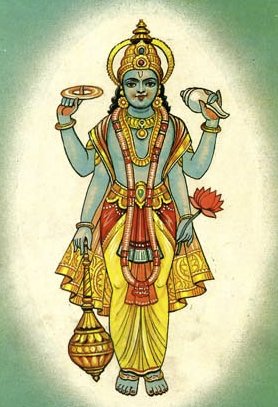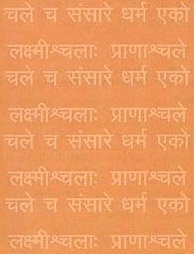Vijnanamaya, Vijñānamaya, Vijnana-maya: 7 definitions
Introduction:
Vijnanamaya means something in Hinduism, Sanskrit. If you want to know the exact meaning, history, etymology or English translation of this term then check out the descriptions on this page. Add your comment or reference to a book if you want to contribute to this summary article.
In Hinduism
Vaishnavism (Vaishava dharma)
Source: Pure Bhakti: Bhagavad-gita (4th edition)Vijñānamaya (विज्ञानमय) refers to “fourth of the five stages of consciousness in which one is conscious of the soul (13.5)”. (cf. Glossary page from Śrīmad-Bhagavad-Gītā).

Vaishnava (वैष्णव, vaiṣṇava) or vaishnavism (vaiṣṇavism) represents a tradition of Hinduism worshipping Vishnu as the supreme Lord. Similar to the Shaktism and Shaivism traditions, Vaishnavism also developed as an individual movement, famous for its exposition of the dashavatara (‘ten avatars of Vishnu’).
Vedanta (school of philosophy)
Source: Shodhganga: Siva Gita A Critical StudyVijñānamaya (विज्ञानमय) or Vijñānamayakośa refers to the “sheath of cognition” and represents one of the five philosophical kośas (“sheaths”) through which the soul functions simultaneously in the various planes or levels of existence.—Vijñānamaya-kośa is the mental or cognitive-intuitive sheath is also called the actinodic sheath. It is the vehicle of higher thought, vijñāna—understanding, knowing, direct cognition, wisdom, intuition and creativity.

Vedanta (वेदान्त, vedānta) refers to a school of orthodox Hindu philosophy (astika), drawing its subject-matter from the Upanishads. There are a number of sub-schools of Vedanta, however all of them expound on the basic teaching of the ultimate reality (brahman) and liberation (moksha) of the individual soul (atman).
Languages of India and abroad
Sanskrit dictionary
Source: DDSA: The practical Sanskrit-English dictionaryVijñānamaya (विज्ञानमय).—a. Full of intelligence; एष विज्ञानमयः पुरुषः (eṣa vijñānamayaḥ puruṣaḥ) Bṛ. Up.2.1.6. °कोषः (koṣaḥ) the soul's sheath of intelligence.
Source: Cologne Digital Sanskrit Dictionaries: Cappeller Sanskrit-English DictionaryVijñānamaya (विज्ञानमय).—[adjective] consisting of knowledge.
Source: Cologne Digital Sanskrit Dictionaries: Monier-Williams Sanskrit-English DictionaryVijñānamaya (विज्ञानमय):—[=vi-jñāna-maya] [from vi-jñāna > vi-jñā] mf(ī)n. consisting of knowledge or intelligence, all kn°, full of intell°, [Śatapatha-brāhmaṇa; Upaniṣad] etc.
[Sanskrit to German]
Sanskrit, also spelled संस्कृतम् (saṃskṛtam), is an ancient language of India commonly seen as the grandmother of the Indo-European language family (even English!). Closely allied with Prakrit and Pali, Sanskrit is more exhaustive in both grammar and terms and has the most extensive collection of literature in the world, greatly surpassing its sister-languages Greek and Latin.
Kannada-English dictionary
Source: Alar: Kannada-English corpusVijñānamaya (ವಿಜ್ಞಾನಮಯ):—
1) [adjective] consisting of knowledge or intelligence.
2) [adjective] full of intelligence.
--- OR ---
Vijñānamaya (ವಿಜ್ಞಾನಮಯ):—[noun] (yoga) the sheath consisting of intelligence; the sheath caused by the understanding being associated with the organs of perception.
Kannada is a Dravidian language (as opposed to the Indo-European language family) mainly spoken in the southwestern region of India.
See also (Relevant definitions)
Partial matches: Maya, Vijnana.
Starts with: Vijnanamayakosha, Vinnanamayakocam.
Full-text: Vijnanamayakosha, Kosha, Vigyaanmay, Vinnanamayakocam, Pancakosha, Annamayakosha, Manomayakosha, Anandamayakosha, Pranamayakosha, Vijnana, Annamaya, Temple, Human body, Panch, Panca.
Relevant text
Search found 28 books and stories containing Vijnanamaya, Vijñāna-maya, Vijnana-maya, Vijṇāna-maya, Vijñānamaya, Vijṇānamaya; (plurals include: Vijnanamayas, mayas, Vijñānamayas, Vijṇānamayas). You can also click to the full overview containing English textual excerpts. Below are direct links for the most relevant articles:
Taittiriya Upanishad Bhashya Vartika (by R. Balasubramanian)
Verse 2.309 < [Book 2 - Brahmavallī]
Verse 2.174 < [Book 2 - Brahmavallī]
Verse 3.23 < [Book 3 - Bhṛguvallī]
Taittiriya Upanishad (by A. Mahadeva Sastri)
Chapter XIV - Vijñānamaya-kośa < [A - Brahmavidyā expounded]
Chapter XV - Ānandamaya-kośa < [A - Brahmavidyā expounded]
Chapter VIII - Brahman the Source of Joy < [B - Brahmavidyā Explained]
Sahitya-kaumudi by Baladeva Vidyabhushana (by Gaurapada Dāsa)
Text 7.33 < [Chapter 7 - Literary Faults]
Text 7.51 < [Chapter 7 - Literary Faults]
Introduction < [Introduction]
Samkhya thoughts in the Mahabharata (by Shini M.V.)
The doctrine of Kośas (five sheaths) < [Chapter 3 - The Philosophical Tenets in the Śānti-parva]
Mundaka Upanishad with Shankara’s Commentary (by S. Sitarama Sastri)
Verse 3.2.7 < [Mundaka III, Khanda II]
A History of Indian Philosophy Volume 2 (by Surendranath Dasgupta)
Part 6 - Vedāntic Cosmology < [Chapter XI - The Śaṅkara School of Vedānta (continued)]